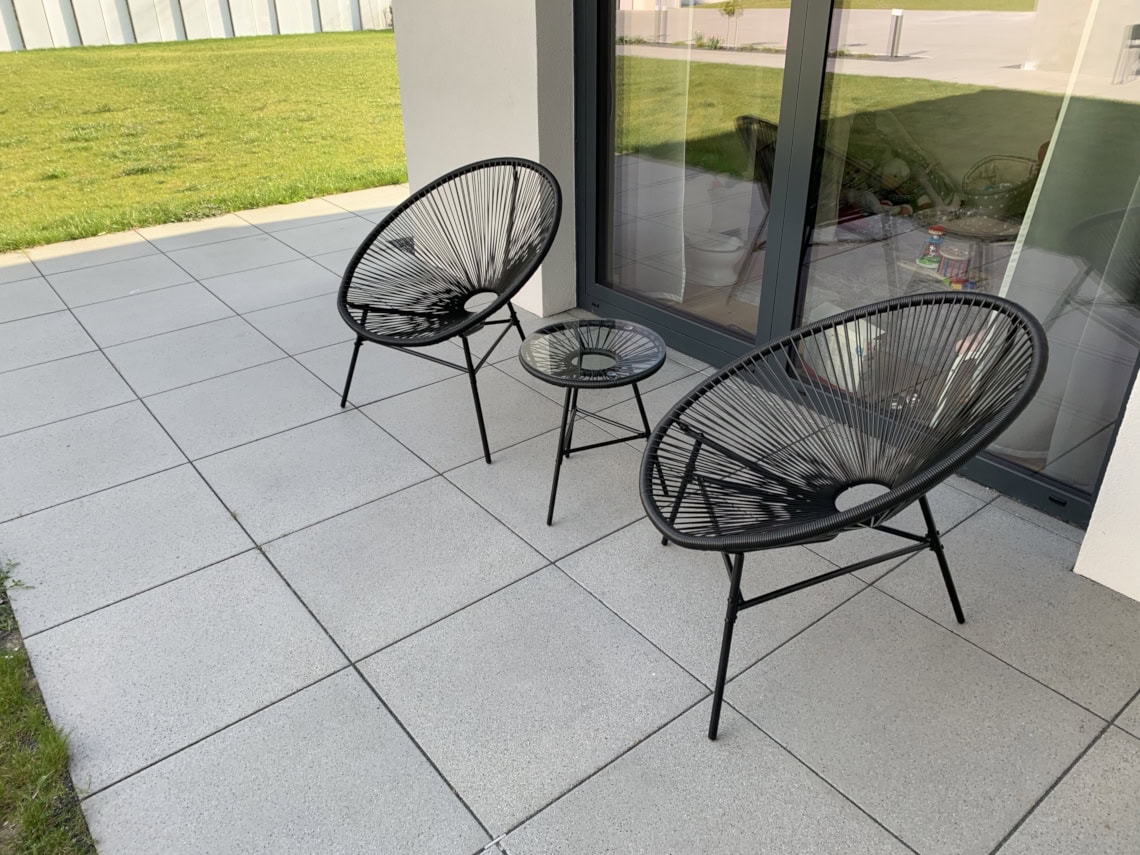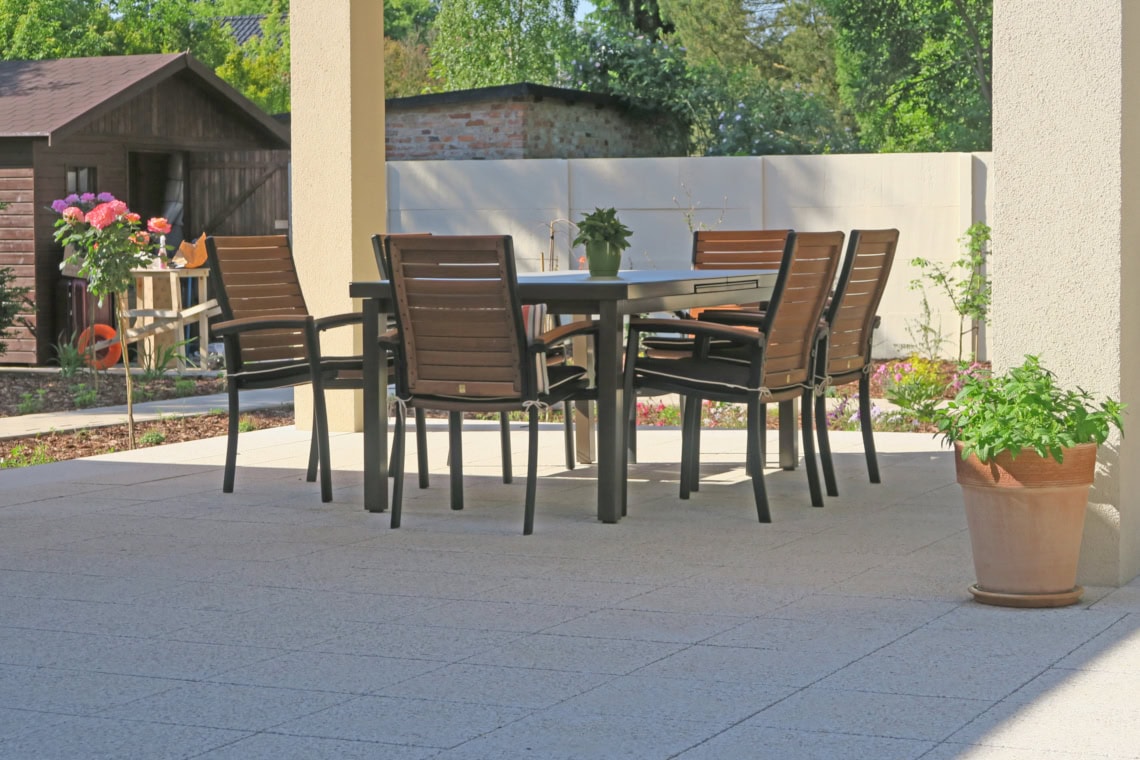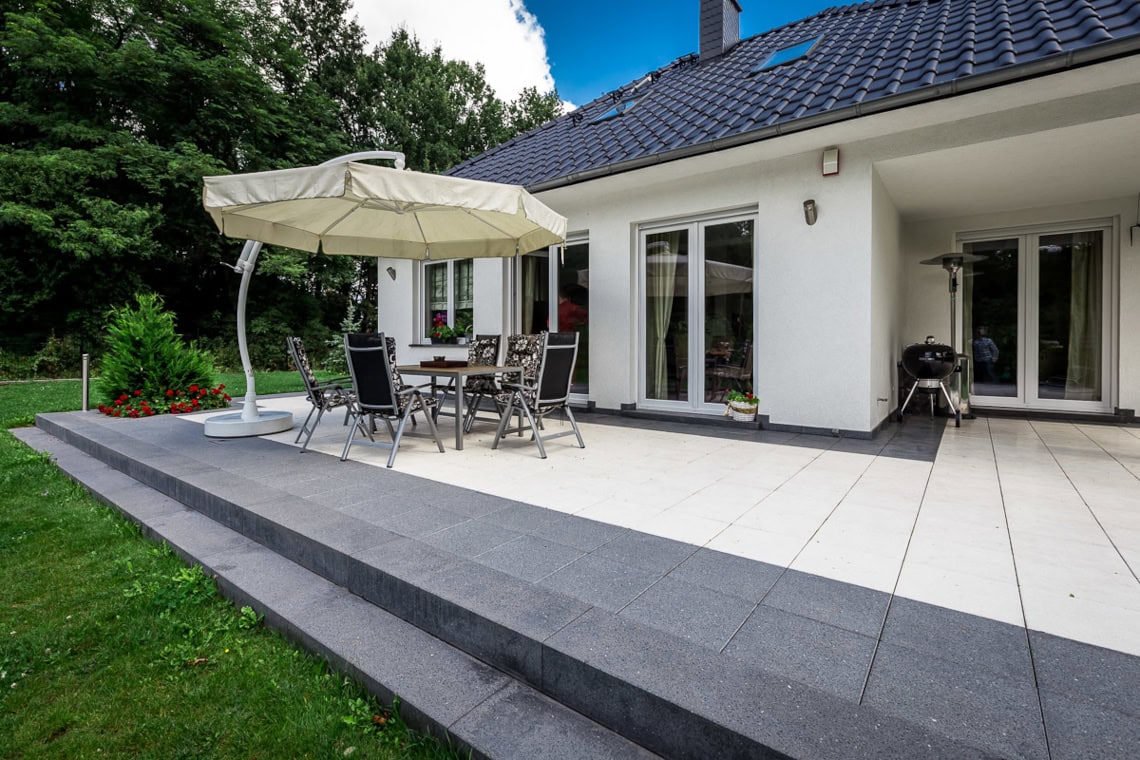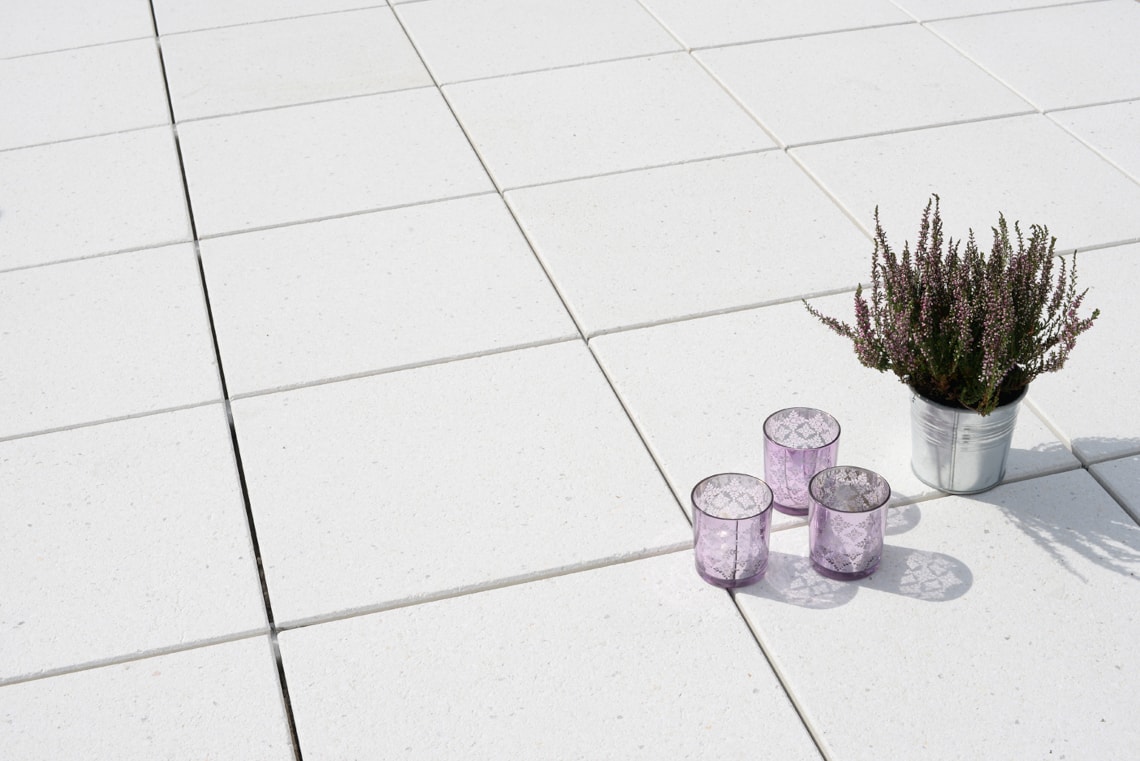
Laying concrete slabs on your terrace is a great way to create an aesthetic and durable surface that will last for years. Concrete terrace tiles are durable, easy to clean and available in various designs and colors, which allows them to match any architectural style, as well as other garden elements. Such a floor is frost-resistant, increases susceptibility to dirt and increases resistance to weather conditions.
Laying concrete slabs on the terrace yourself can be a rewarding project, as long as we carefully plan and execute each step. In the following article, we will discuss the different methods of laying terrace tiles, as well as provide detailed instructions and tips to help you lay the tiles on your terrace correctly.
Dry laying of terrace tiles (on the ground)
Laying terrace slabs made of concrete dry, i.e. without the use of mortar, is one of the easiest and fastest ways to create a terrace. This method consists in laying slabs directly on the native soil, which allows for easy and quick finishing works of the earth terrace and laying individual slabs on the ground.
How to prepare the substrate before laying terrace concrete slabs on it?
Before laying concrete terrace slabs, the surface must be prepared and leveled. The first step is to level the ground. To lay slabs on the ground, start by removing the topsoil and leveling the ground.
It consists in removing humus and native soil at a depth of approx. 20 cm, which are located in the place where the terrace is made, to prevent the penetration of impurities from the ground. Such preparation of the surface reduces susceptibility to dirt and damage.
Then it is worth using a layer of geotextile to prevent weeds from the bottom of the excavation from overgrowing and the appearance of dirt or impurities from the ground on the slabs. The next stage is to make a load-bearing layer of crushed stone or gravel, which will ensure stability and proper water drainage. The thickness of the layer should be between 10 cm and 20-30 cm. This layer should be thoroughly compacted using a compactor until it is completely filled with ballast.
How important is the right ballast and slope?
Terrace slabs are laid on a specially prepared ballast. Ballast, i.e. a layer of sand or fine grit of 1-3 mm, plays a key role in the process of dry laying concrete slabs. The ballast facilitates precise positioning of the panels and prevents them from moving.
An important element of such a screed is also to ensure an appropriate slope of the substrate – about 1-2% – which will enable efficient drainage of rainwater from the terrace surface. An improper slope can lead to puddles and damage to the terrace structure, so it should be done before starting to lay the tiles.
Laying terrace tiles on the prepared surface
After proper preparation of the substrate, you can start laying terrace tiles. The boards should be laid according to the planned pattern, remembering to keep equal spacing between them, and paying attention to where the top edge of the board is. It is worth using a rubber mallet to gently hammer the surface of the boards so that it stays firmly in the ground.
The next step – grouting the gaps between the slabs
After laying all the terrace slabs, we start grouting the joints. For this purpose, you can use sand or a special grouting mixture, which should be evenly spread over the surface of the terrace and swept into the gaps. The grout ensures the aesthetic appearance of the terrace and prevents weeds from overgrowing between the slabs.
You can also opt for impregnation. Impregnation of the surface reduces susceptibility to damage, thanks to which the slabs retain their aesthetic appearance for longer.
What are the advantages of a terrace on concrete slab ground?
A terrace on concrete slabs has many advantages. First of all, it is an economical solution and relatively easy to implement. This is a much better solution than, for example, wooden or ceramic boards, which are not very suitable for designing the external surface.
Concrete slabs, due to the use of high-quality aggregate, are very durable and resistant to weather conditions, which means that the terrace will serve for many years. A wide range of available designs and colors allows you to create a terrace perfectly suited to your individual needs and tastes to design a unique home and garden.

Laying terrace slabs on concrete
Laying terrace slabs on a concrete substrate is a more advanced method that provides exceptional durability and stability of the terrace. This method consists in laying slabs on a previously prepared concrete substructure, which we create next to the building towards the garden.
How to properly make a concrete substructure for a terrace?
The concrete foundation for the terrace requires proper preparation. Start by digging a trench to a depth of about 30-40 cm, and then fill it with a layer of crushed stone or gravel, which will provide drainage. Gravel is spread on the surface and spread with a brush.
The next step is to make a concrete substructure about 10-15 cm thick. The concrete should be well compacted and leveled to provide a stable substrate for terrace slabs.
Construction of a terrace on a concrete substrate
After proper preparation of the concrete substructure, you can start laying terrace slabs. The boards should be laid on a layer of adhesive or mortar, which will ensure their permanent adhesion to the substrate. It is also important to maintain adequate spacing between the plates and to check the level regularly to avoid unevenness.
Laying a terrace on a concrete substrate – benefits
Laying a terrace on a concrete substrate has many advantages. First of all, it provides exceptional durability and stability of the structure, which is especially important in the case of large and intensively used terraces. The concrete substructure effectively prevents slabs from settling and minimizes the risk of unevenness. In addition, tiles laid on a concrete substrate are extremely resistant to extreme weather conditions and mechanical damage.

Rubber hammer, compactor – what equipment will be needed to lay a concrete terrace?
To lay a concrete terrace, you will need various tools and equipment. The most important of them is a compactor that will allow for the appropriate compaction of the load-bearing layer and the concrete substructure. A rubber mallet will be necessary to gently drive the boards into the mortar, which will ensure their stable adhesion to the substrate. It is also worth getting a spirit level to regularly check the level of the laid slabs and a grouting brush to help distribute the grout material evenly.
We invite you to familiarize yourself with the terrace tiles offered by our company
If you are planning to build a terrace and are looking for high-quality materials, we encourage you to familiarize yourself with our offer of terrace tiles. Concrete slabs for terraces from our offer are characterized not only by high durability, but also by aesthetic appearance and a variety of patterns. With our products, you will create a terrace that is not only functional, but also beautiful and tailored to your taste.

